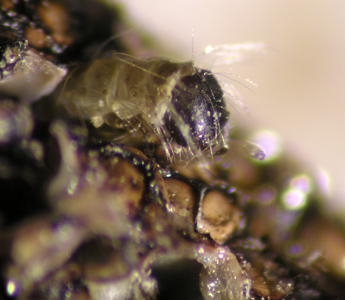Winter weather not a serious threat to eastern tent caterpillar eggs
Winter weather not a serious threat to eastern tent caterpillar eggs

Published on March 12, 2014
Blasts of polar air across Kentucky made this winter one to remember for many, but experts say the eastern tent caterpillar probably didn’t take notice.
This insect spends the winter as tiny, fully developed caterpillars in distinctive egg masses that encircle twigs of wild cherry and related tree species. The eastern tent caterpillar is one of the first insects to become active in the spring and is well adapted to survive Kentucky’s often erratic winter and early spring weather.
“Hardy may be too mild a term for them. Laboratory studies have shown that caterpillars in the egg can withstand temperatures down to 31 below zero Fahrenheit,” said Lee Townsend, University of Kentucky College of Agriculture, Food and Environment extension entomologist. “It has been a cold winter, but temperatures have not been low enough to expect a significant reduction in egg hatch this spring.”
According to Townsend, dissections of some eggs collected in early March show a nearly 80 percent survival, which is typical of most years. That is also the same rate determined in studies by UK entomology researchers during the 1999-2001 Mare Reproductive Loss Syndrome, which resulted in staggering losses of foals. MRLS can cause late-term foal losses, early- and late-term fetal losses and weak foals. Subsequent studies by UK researchers revealed that horses will inadvertently eat the caterpillars, and the caterpillar hairs embed into the lining of the alimentary tract. Once that protective barrier is breached, normal alimentary tract bacteria may gain access to and reproduce in sites with reduced immunity, such as the fetus and placenta.
“The growth and development of many insects is directly dependent on temperature. Usually, this allows relatively accurate predictions of egg hatch and development. Unfortunately, the eastern tent caterpillar is an exception,” Townsend said. “Predictive models using degree-day information can provide a general idea of when egg hatch can occur, but actual hatch in the field is variable.
“In fact, eggs from a single mass usually hatch over about a two-week period, not all at once,” he said. “This is an important survival mechanism that protects the species from high mortality. Prolonged egg hatch increases the chances of species survival, even if some early caterpillars are killed by freezes or heavy rains during early spring.”
According to Townsend, Kentucky arborist Larry Hanks has tracked the eastern tent caterpillar egg hatch in Central Kentucky since 2001. His earliest observation of a hatch was March 13, 2012. The latest was April 4, 2013. Typically, the caterpillars first appear during the second or third week of March.
“It is still too early to provide a general prediction for 2014,” Townsend said. “Continued cold will slow development, but a string of 70 degree days can cause egg hatch to begin in a short time.”
According to Townsend, eastern tent caterpillar populations seem to have increased over the past five to seven years, with numerous tents visible in wild cherry trees along fence lines in some areas of the state. Regrowth and sprouting of new trees may have resulted in increases in host trees and, subsequently, the caterpillars.
To get rid of active caterpillars, Townsend recommends pruning them out and destroying the nests as they are seen, if practical. Any one of several insecticides registered for use on shade trees can also be used to treat as needed. Spot treatments to the tents and/or the foliage around them can be applied according to label directions, which vary by product.
“This is a good time to prepare,” Townsend said. “Begin by checking pasture fence lines to see how abundant wild cherry is in them. If practical, plan to move pregnant mares from areas where these trees are abundant to minimize the chance of exposure to the caterpillars. The potential is greatest when the mature tent caterpillars leave trees and wander to find places to pupate and transform to the moth stage.”
Entomology Ag Equine Programs Extension Weather

